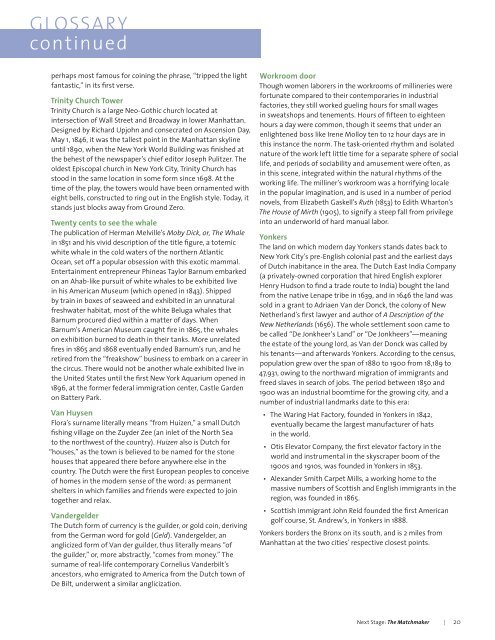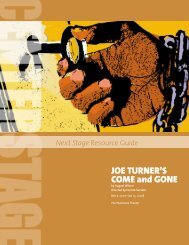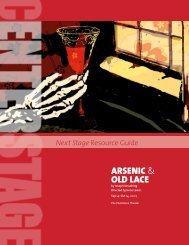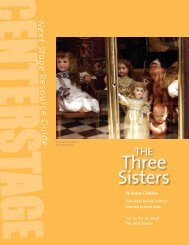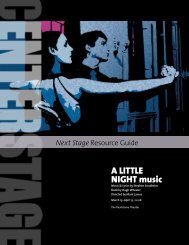The Matchmaker - Center Stage
The Matchmaker - Center Stage
The Matchmaker - Center Stage
Create successful ePaper yourself
Turn your PDF publications into a flip-book with our unique Google optimized e-Paper software.
Glossary<br />
continued<br />
perhaps most famous for coining the phrase, “tripped the light<br />
fantastic,” in its first verse.<br />
trinity Church tower<br />
Trinity Church is a large Neo-Gothic church located at<br />
intersection of Wall Street and Broadway in lower Manhattan.<br />
Designed by Richard Upjohn and consecrated on Ascension Day,<br />
May 1, 1846, it was the tallest point in the Manhattan skyline<br />
until 1890, when the New York World Building was finished at<br />
the behest of the newspaper’s chief editor Joseph Pulitzer. <strong>The</strong><br />
oldest Episcopal church in New York City, Trinity Church has<br />
stood in the same location in some form since 1698. At the<br />
time of the play, the towers would have been ornamented with<br />
eight bells, constructed to ring out in the English style. Today, it<br />
stands just blocks away from Ground Zero.<br />
twenty cents to see the whale<br />
<strong>The</strong> publication of Herman Melville’s Moby Dick, or, <strong>The</strong> Whale<br />
in 1851 and his vivid description of the title figure, a totemic<br />
white whale in the cold waters of the northern Atlantic<br />
Ocean, set off a popular obsession with this exotic mammal.<br />
Entertainment entrepreneur Phineas Taylor Barnum embarked<br />
on an Ahab-like pursuit of white whales to be exhibited live<br />
in his American Museum (which opened in 1843). Shipped<br />
by train in boxes of seaweed and exhibited in an unnatural<br />
freshwater habitat, most of the white Beluga whales that<br />
Barnum procured died within a matter of days. When<br />
Barnum’s American Museum caught fire in 1865, the whales<br />
on exhibition burned to death in their tanks. More unrelated<br />
fires in 1865 and 1868 eventually ended Barnum’s run, and he<br />
retired from the “freakshow” business to embark on a career in<br />
the circus. <strong>The</strong>re would not be another whale exhibited live in<br />
the United States until the first New York Aquarium opened in<br />
1896, at the former federal immigration center, Castle Garden<br />
on Battery Park.<br />
van Huysen<br />
Flora’s surname literally means “from Huizen,” a small Dutch<br />
fishing village on the Zuyder Zee (an inlet of the North Sea<br />
to the northwest of the country). Huizen also is Dutch for<br />
“houses,” as the town is believed to be named for the stone<br />
houses that appeared there before anywhere else in the<br />
country. <strong>The</strong> Dutch were the first European peoples to conceive<br />
of homes in the modern sense of the word: as permanent<br />
shelters in which families and friends were expected to join<br />
together and relax.<br />
vandergelder<br />
<strong>The</strong> Dutch form of currency is the guilder, or gold coin, deriving<br />
from the German word for gold (Geld). Vandergelder, an<br />
anglicized form of Van der guilder, thus literally means “of<br />
the guilder,” or, more abstractly, “comes from money.” <strong>The</strong><br />
surname of real-life contemporary Cornelius Vanderbilt’s<br />
ancestors, who emigrated to America from the Dutch town of<br />
De Bilt, underwent a similar anglicization.<br />
Workroom door<br />
Though women laborers in the workrooms of millineries were<br />
fortunate compared to their contemporaries in industrial<br />
factories, they still worked gueling hours for small wages<br />
in sweatshops and tenements. Hours of fifteen to eighteen<br />
hours a day were common, though it seems that under an<br />
enlightened boss like Irene Molloy ten to 12 hour days are in<br />
this instance the norm. <strong>The</strong> task-oriented rhythm and isolated<br />
nature of the work left little time for a separate sphere of social<br />
life, and periods of sociability and amusement were often, as<br />
in this scene, integrated within the natural rhythms of the<br />
working life. <strong>The</strong> milliner’s workroom was a horrifying locale<br />
in the popular imagination, and is used in a number of period<br />
novels, from Elizabeth Gaskell’s Ruth (1853) to Edith Wharton’s<br />
<strong>The</strong> House of Mirth (1905), to signify a steep fall from privilege<br />
into an underworld of hard manual labor.<br />
yonkers<br />
<strong>The</strong> land on which modern day Yonkers stands dates back to<br />
New York City’s pre-English colonial past and the earliest days<br />
of Dutch inabitance in the area. <strong>The</strong> Dutch East India Company<br />
(a privately-owned corporation that hired English explorer<br />
Henry Hudson to find a trade route to India) bought the land<br />
from the native Lenape tribe in 1639, and in 1646 the land was<br />
sold in a grant to Adriaen Van der Donck, the colony of New<br />
Netherland’s first lawyer and author of A Description of the<br />
New Netherlands (1656). <strong>The</strong> whole settlement soon came to<br />
be called “De Jonkheer’s Land” or “De Jonkheers”—meaning<br />
the estate of the young lord, as Van der Donck was called by<br />
his tenants—and afterwards Yonkers. According to the census,<br />
population grew over the span of 1880 to 1900 from 18,189 to<br />
47,931, owing to the northward migration of immigrants and<br />
freed slaves in search of jobs. <strong>The</strong> period between 1850 and<br />
1900 was an industrial boomtime for the growing city, and a<br />
number of industrial landmarks date to this era:<br />
•<br />
•<br />
•<br />
•<br />
<strong>The</strong> Waring Hat Factory, founded in Yonkers in 1842,<br />
eventually became the largest manufacturer of hats<br />
in the world.<br />
Otis Elevator Company, the first elevator factory in the<br />
world and instrumental in the skyscraper boom of the<br />
1900s and 1910s, was founded in Yonkers in 1853.<br />
Alexander Smith Carpet Mills, a working home to the<br />
massive numbers of Scottish and English immigrants in the<br />
region, was founded in 1865.<br />
Scottish immigrant John Reid founded the first American<br />
golf course, St. Andrew’s, in Yonkers in 1888.<br />
Yonkers borders the Bronx on its south, and is 2 miles from<br />
Manhattan at the two cities’ respective closest points.<br />
Next <strong>Stage</strong>: <strong>The</strong> <strong>Matchmaker</strong> | 0


